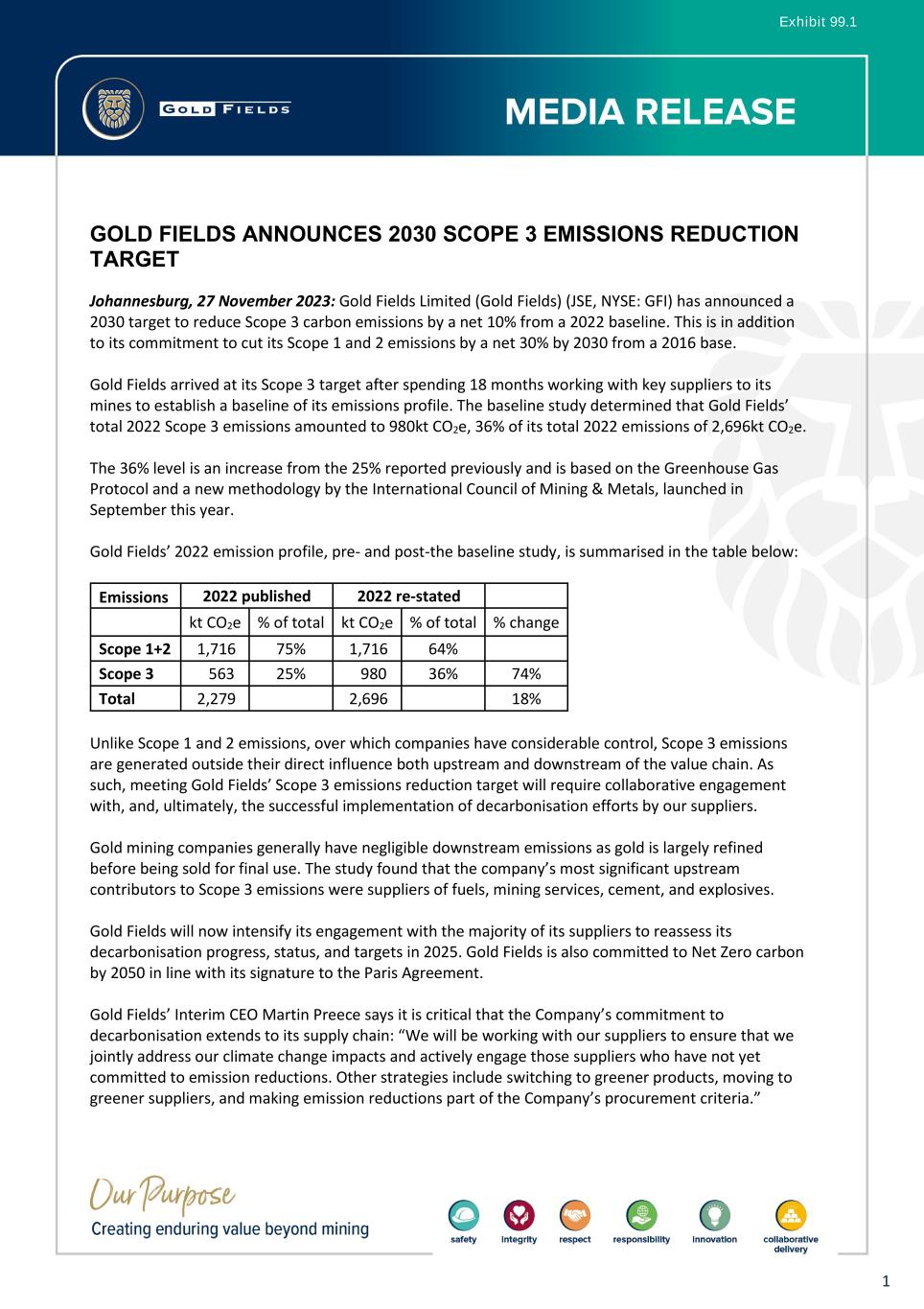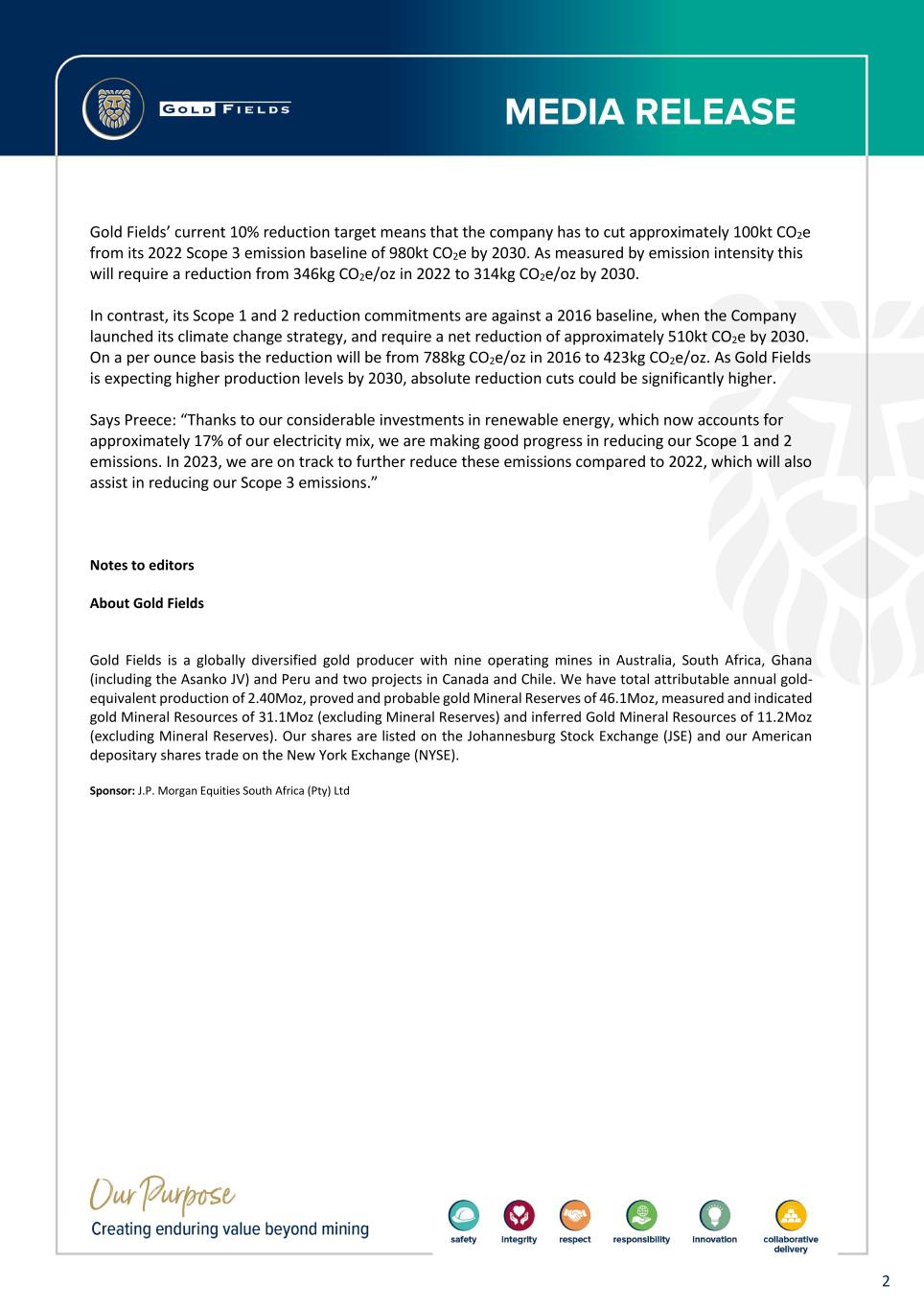
1 GOLD FIELDS ANNOUNCES 2030 SCOPE 3 EMISSIONS REDUCTION TARGET Johannesburg, 27 November 2023: Gold Fields Limited (Gold Fields) (JSE, NYSE: GFI) has announced a 2030 target to reduce Scope 3 carbon emissions by a net 10% from a 2022 baseline. This is in addition to its commitment to cut its Scope 1 and 2 emissions by a net 30% by 2030 from a 2016 base. Gold Fields arrived at its Scope 3 target after spending 18 months working with key suppliers to its mines to establish a baseline of its emissions profile. The baseline study determined that Gold Fields’ total 2022 Scope 3 emissions amounted to 980kt CO2e, 36% of its total 2022 emissions of 2,696kt CO2e. The 36% level is an increase from the 25% reported previously and is based on the Greenhouse Gas Protocol and a new methodology by the International Council of Mining & Metals, launched in September this year. Gold Fields’ 2022 emission profile, pre- and post-the baseline study, is summarised in the table below: Emissions 2022 published 2022 re-stated kt CO2e % of total kt CO2e % of total % change Scope 1+2 1,716 75% 1,716 64% Scope 3 563 25% 980 36% 74% Total 2,279 2,696 18% Unlike Scope 1 and 2 emissions, over which companies have considerable control, Scope 3 emissions are generated outside their direct influence both upstream and downstream of the value chain. As such, meeting Gold Fields’ Scope 3 emissions reduction target will require collaborative engagement with, and, ultimately, the successful implementation of decarbonisation efforts by our suppliers. Gold mining companies generally have negligible downstream emissions as gold is largely refined before being sold for final use. The study found that the company’s most significant upstream contributors to Scope 3 emissions were suppliers of fuels, mining services, cement, and explosives. Gold Fields will now intensify its engagement with the majority of its suppliers to reassess its decarbonisation progress, status, and targets in 2025. Gold Fields is also committed to Net Zero carbon by 2050 in line with its signature to the Paris Agreement. Gold Fields’ Interim CEO Martin Preece says it is critical that the Company’s commitment to decarbonisation extends to its supply chain: “We will be working with our suppliers to ensure that we jointly address our climate change impacts and actively engage those suppliers who have not yet committed to emission reductions. Other strategies include switching to greener products, moving to greener suppliers, and making emission reductions part of the Company’s procurement criteria.”

2 Gold Fields’ current 10% reduction target means that the company has to cut approximately 100kt CO2e from its 2022 Scope 3 emission baseline of 980kt CO2e by 2030. As measured by emission intensity this will require a reduction from 346kg CO2e/oz in 2022 to 314kg CO2e/oz by 2030. In contrast, its Scope 1 and 2 reduction commitments are against a 2016 baseline, when the Company launched its climate change strategy, and require a net reduction of approximately 510kt CO2e by 2030. On a per ounce basis the reduction will be from 788kg CO2e/oz in 2016 to 423kg CO2e/oz. As Gold Fields is expecting higher production levels by 2030, absolute reduction cuts could be significantly higher. Says Preece: “Thanks to our considerable investments in renewable energy, which now accounts for approximately 17% of our electricity mix, we are making good progress in reducing our Scope 1 and 2 emissions. In 2023, we are on track to further reduce these emissions compared to 2022, which will also assist in reducing our Scope 3 emissions.” Notes to editors About Gold Fields Gold Fields is a globally diversified gold producer with nine operating mines in Australia, South Africa, Ghana (including the Asanko JV) and Peru and two projects in Canada and Chile. We have total attributable annual gold- equivalent production of 2.40Moz, proved and probable gold Mineral Reserves of 46.1Moz, measured and indicated gold Mineral Resources of 31.1Moz (excluding Mineral Reserves) and inferred Gold Mineral Resources of 11.2Moz (excluding Mineral Reserves). Our shares are listed on the Johannesburg Stock Exchange (JSE) and our American depositary shares trade on the New York Exchange (NYSE). Sponsor: J.P. Morgan Equities South Africa (Pty) Ltd

3 Forward-looking statements This announcement contains forward-looking statements within the meaning of the “safe harbour” provisions of the Private Securities Litigation Reform Act of 1995. All statements other than statements of historical fact included in this announcement may be forward-looking statements. Forward-looking statements may be identified by the use of words such as “aim”, “anticipate”, “will”, “would”, “expect”, “may”, “could”, “believe”, “target”, “estimate”, “project” and words of similar meaning. These forward-looking statements, including among others, those relating to Gold Fields’ future business prospects, financial positions, production and operational guidance, climate and ESG-related statements, targets and metrics, are necessary estimates reflecting the best judgement of the senior management of Gold Fields and involve a number of risks and uncertainties that could cause actual results to differ materially from those suggested by the forward-looking statements. By their nature, forward-looking statements involve risk and uncertainty because they relate to future events and circumstances and should be considered in light of various important factors, including those set forth in Gold Fields’ Integrated Annual Report 2022 filed with the Johannesburg Stock Exchange and annual report on Form 20-F filed with the United States Securities and Exchange Commission (SEC) on 30 March 2023 (SEC File no. 001-31318). Readers are cautioned not to place undue reliance on such statements. These forward-looking statements speak only as of the date they are made. Gold Fields undertakes no obligation to update publicly or release any revisions to these forward-looking statements to reflect events or circumstances after the date of this announcement or to reflect the occurrence of unanticipated events. These forward-looking statements have not been reviewed or reported on by the Company’s external auditors. This announcement also contains data on Gold Fields’ Scope 1, 2 and 3 greenhouse gas emissions. Data for Scope 1 and 2 emissions relate to Gold Fields’ own activities and supplied heat, power, and cooling which are measured using data from its own systems and independently assured, as described in our 2022 Climate Change Report. Scope 3 emissions relate to other organisations’ emissions and are therefore subject to a range of uncertainties and challenges. At present Scope 3 data is not yet consistently available in many value chains and is calculated, collected, or estimated in different ways. Gold Fields’ Scope 3 emissions data is determined using the ISO 14064 part 1 standard. As value chain emissions data advances over time, Gold Fields expects to improve the quality of its Scope 3 data and data reporting.


